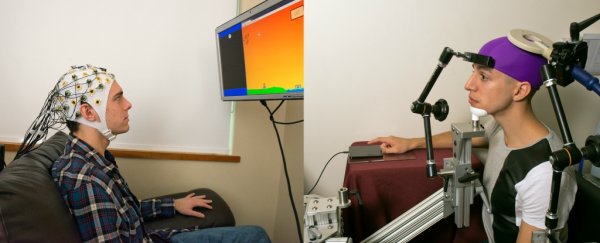Scientists in the US have linked up the brains of participants almost 1.5 km apart, allowing them to play a 20 questions-style game using nothing but their thoughts.
This is the first experiment to demonstrate that two brains can be linked up directly to allow one person to accurately guess what's on the other's mind, and it's a pretty huge deal.
The experiment involved a question-and-answer game, but instead of asking each other questions in person, the participants were put in separate buildings and were not allowed to talk to each other or communicate using anything but thoughts transmitted over the Internet.
Using this system, participants were able to correctly guess the object that their partner was thinking of 72 percent of the time.
"This is the most complex brain-to-brain experiment, I think, that's been done to date in humans," lead researcher Andrea Stocco from the University of Washington said in a press release. "It uses conscious experiences through signals that are experienced visually, and it requires two people to collaborate."
During the experiment, one participant - "the respondent" - was hooked up to an electroencephalography (EEG) cap, which recorded all their brain activity. Meanwhile, their partner - "the inquirer" - was sitting in a room around 1.5 km away, and had a magnetic coil positioned around their head.
Each round, the respondent would think of an object, say a dog, and the inquirer would then click on a yes or no question like, "Is the object an animal?" which would appear on a screen in front of their partner. Depending on the answer, the respondent would concentrate on one of two LED lights in front of them.
And this is where things get really cool. When the respondent concentrated on the "yes" light, their brain pattern activated the magnetic coil over the inquirer's head, causing them to see a visual hallucination called a 'phosphene'. This most commonly takes the form of a flash or a thin line of light, and it would let the inquirer know that the answer was yes. No flash of light meant no. From there, they could ask more questions before identifying what they thought the item was.
The researchers repeated the experiment over 20 rounds - 10 control games where the brain-to-brain link wasn't working and 10 proper rounds - and took strict precautions to make sure no one could cheat.
The participants were able to guess the objects correctly in 72 percent of the real rounds, compared to only 18 percent of the control rounds. And the team believes many of those incorrect guesses were caused by the inquirers not being able to recognise the phosphene, or visual hallucination, that signalled a 'yes' response.
"They have to interpret something they're seeing with their brains," said one of the researchers, Chantel Prat. "It's not something they've ever seen before."
The team hopes that their research will one day allow them to directly transfer signals from one person's brain into another, helping to effectively 'upload' knowledge.
It could even allow healthy brains to 'tutor' ones that are impaired - for example, the technology could transfer signals from a healthy person's brain directly into the brain of someone in a coma, or someone with a neurodegenerative disorder such as Alzheimer's disease.
"Imagine having someone with ADHD and a neurotypical student," said Prat. "When the non-ADHD student is paying attention, the ADHD student's brain gets put into a state of greater attention automatically."
There's a long way to go before we're at that stage, but in the two years since the first direct brain-to-brain connection was established - by the same research team, incidentally, back in 2013 - we've already made some pretty exciting progress. We're looking forward to seeing what happens next.
The results have been published in PLOS ONE.
